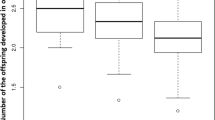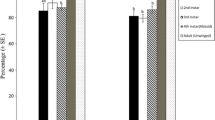Abstract
The effect of maternal crowding on the offspring sex ratio of a cereal aphid parasitoid Lysiphlebus delhiensis (Subba Rao & Sharma) (Hymenoptera: Braconidae) was examined. Increasing the number of mothers per host-patch always increased the proportion of males in the population (p). The extent of variations in p at different levels of maternal crowding was compared with the prediction of the Hamiltonian LMC model, i.e. p = (n-1)/2n, where n = number of mothers/host-patch. The perception of trace odours of conspecific females induced haploid oviposition. Differential mortality of the larvae by sex in superparasitised hosts, shifting the p towards sons has been discussed. The inversely parasitoid-density-dependent p indicates that for obtaining maximum number of female progeny, the ratio of female parasitoid to the host in mass breeding should not be less than 1:100 at a time.
Résumé
L’effet de la surpopulation maternelle sur le rapport des sexes dans la progéniture d’un parasitoüde du puceron des céréales Lysiphlebus delhiensis (Subba Rao & Sharma) a été examiné. L’augmentation du nombre de mères par hôte s’accompagnait toujours d’une augmentation de la proportion des mâles dans la population (p). Le degré des variations de p à différents niveaux de surpopulation maternelle a été comparé à la prédiction du modèle Hamiltonian LMC, à savoir p = (n-1)/2n, où n = le nombre de mères/hôte. La perception des traces d’odours de femelles conspécifiques induisait la production d’oeufs haploüdes. La mortalité larvaire differentielle par sexe chez les hôtes superparasites, faisant basculer les valeurs de p en faveur des mâles a été discutée. Les valeurs de p en rapport inverse de la densité du parasitoüde montre que pour obtenir un nombre maximal de femelles dans la progéniture, le rapport du parasitoüde femelle par hôte en élevage en masse ne devrait jamais être inférieur à 1:100.
Similar content being viewed by others
References
Bhatt N. and Singh R. (1991a) Bionomics of an aphidiid parasitoid Trioxys indicus Subba Rao & Sharma. 33. Impact of food plants on the behaviour of and sex allocation by the female parasitoid at varying densities. Biol Agric. Hort. 7, 247–259.
Bhatt N. and Singh R. (1991b) Impact of male parasitoid Trioxys indicus on the reproductive strategy of the female on different food plants. Indian J. Ecol. 18, 36–40.
Decker U. M., Powell P. W. and Clark S. J. (1993) Sex pheromones in the cereal aphid parasitoids Praon volucre and Aphidius rhopalosiphi. Entomol Exp. Appl. 69, 33–39.
Fisher R. A. (1930) The Genetic Theory of Natural Selection. Oxford University Press, London.
Hamilton W. D. (1967) Extraordinary sex ratios. Science 156, 477–488.
Holmes H. B. (1972) Genetic evidence for fewer progeny and higher percent males when Nasonia vitripennis oviposits in previously parasitised hosts. Entomophaga 17, 79–88.
King B. H. (1987) Offspring sex ratios in parasitic wasps. Q. Rev. Biol. 62, 367–396.
King B. H. (1989) A test of local mate competition theory with a solitary species of parasitoid wasp, Spalangia cameroni. Oikos 54, 50–54.
Mishra S. and Singh R. (1990a) Effect of parasitisation by the cereal aphid parasitoid Lysiphlebus delhiensis (Subba Rao & Sharma) (Hymenoptera: Aphidiidae) at its varying densities. J. Appl Entomol. 109, 251–261.
Mishra S. and Singh R. (1990b) Life-time performance of an aphid parasitoid Lysiphlebus delhiensis (Hymenoptera: Aphidiidae). Entomol Gen. 15, 173–179.
Mishra S. and Singh R. (1991) Sex ratio of the aphid parasitoid Lysiphlebus delhiensis (Subba Rao & Sharma) (Hymenoptera: Aphidiidae) in field population. J. Appl Entomol. 111, 72–77.
Mishra S. and Singh R. (1993) Factors affecting supernumerary egg deposition by the parasitoid Lysiphlebus delhiensis (Subba Rao & Sharma) (Hymenoptera: Aphidiidae) into its host Rhopalosiphum maidis (Fitch). Biol Agric. Hort. 10, 39–45.
Nunney L. (1985) Female-biased sex ratios: Individual or group selection? Evolution 39, 349–361.
Singh R. and Agarwala B. K. (1992) Biology, ecology and control efficiency of the aphid parasitoid Trioxys indicus: A review and bibliography. Biol. Agric. Hort. 8, 271–298.
Singh R. and Sinha T. B. (1982) Bionomics of Trioxys indicus, an aphidiid parasitoid of Aphis craccivora. 10. Superparasitism caused by confinemenat with the hosts. Entomol Exp. Appl. 32, 227–231.
Sinha T. B. and Singh R. (1979) Studies on the bionomics of Trioxys (Binodoxys) indicus (Hymenoptera: Aphidiidae). Effect of population densities on the sex ratio. Entomophaga 24, 289–294.
Sinha T. B. and Singh R. (1980) Bionomics of Trioxys (Binodoxys) indicus, an aphidiid parasitoid of Aphis craccivora. 3. Numerical aspects of interaction of the parasitoid and its host. Entomol Exp. Appl. 28, 167–176.
Srivastava M. and Singh R. (1994) Sex ratio adjustment by a koinobiotic parasitoid Lysiphlebus delhiensis (Subba Rao & Sharma) (Hymenoptera: Aphidiidae) in response to host size. Biol Agric. Hort. 12, 15–28.
Suzuki Y., Tsuji H. and Sasakawa M. (1984) Sex allocation and the effects of superparasitism on secondary sex ratios in the gregarious parasitoid, Trichogramma chilonis (Hymenoptera: Trichogrammatidae). Anim. Behav. 32, 478–484.
Tripathi R. N. and Singh R. (1991) Progeny and sex allocation by an aphidiid parasitoid Lysiphlebia mirzai (Hymenoptera: Aphidiidae) at different parasitoid-host ratios. Entomol. Gen. 16, 23–30.
Viktorov G. A. and Kochetova N. I. (1973) The role of trace pheromones in regulating sex ratio in Trissolcus grandis (Hymenoptera: Scelionidae). Zh. Obsch. Biol. 34, 559–562.
Wylie H. G. (1966) Some mechanisms that affect the sex ratio of Nasonia vitripennis (Walk.) (Hymenoptera: Pteromalidae) reared from superparasitised housefly pupae. Can. Entomol. 98, 645–653.
Wylie H. G. (1973) Control of egg fertilisation by Nasonia vitripennis (Hymenoptera: Pteromalidae) when laying on parasitised housefly pupae. Can. Entomol 105, 709–718.
Wylie H. G. (1976) Interference among females of Nasonia vitripennis (Hymenoptera: Pteromalidae) and its effect on sex ratio of their progeny. Can. Entomol. 108, 655–661.
Author information
Authors and Affiliations
Rights and permissions
About this article
Cite this article
Biswas, S., Singh, R. Offspring Sex Ratio of a Cereal Aphid Parasitoid, Lysiphlebus delhiensis (Subba Rao & Sharma) in Response to Maternal Crowding. Int J Trop Insect Sci 16, 287–291 (1995). https://doi.org/10.1017/S1742758400017306
Accepted:
Published:
Issue Date:
DOI: https://doi.org/10.1017/S1742758400017306
Key Words
- Lysiphlebus delhiensis
- Melanaphis sacchari
- Zea mays
- aphids
- parasitism
- Aphididae
- biological control
- sex ratio
- parasitoid density
- maternal crowding




